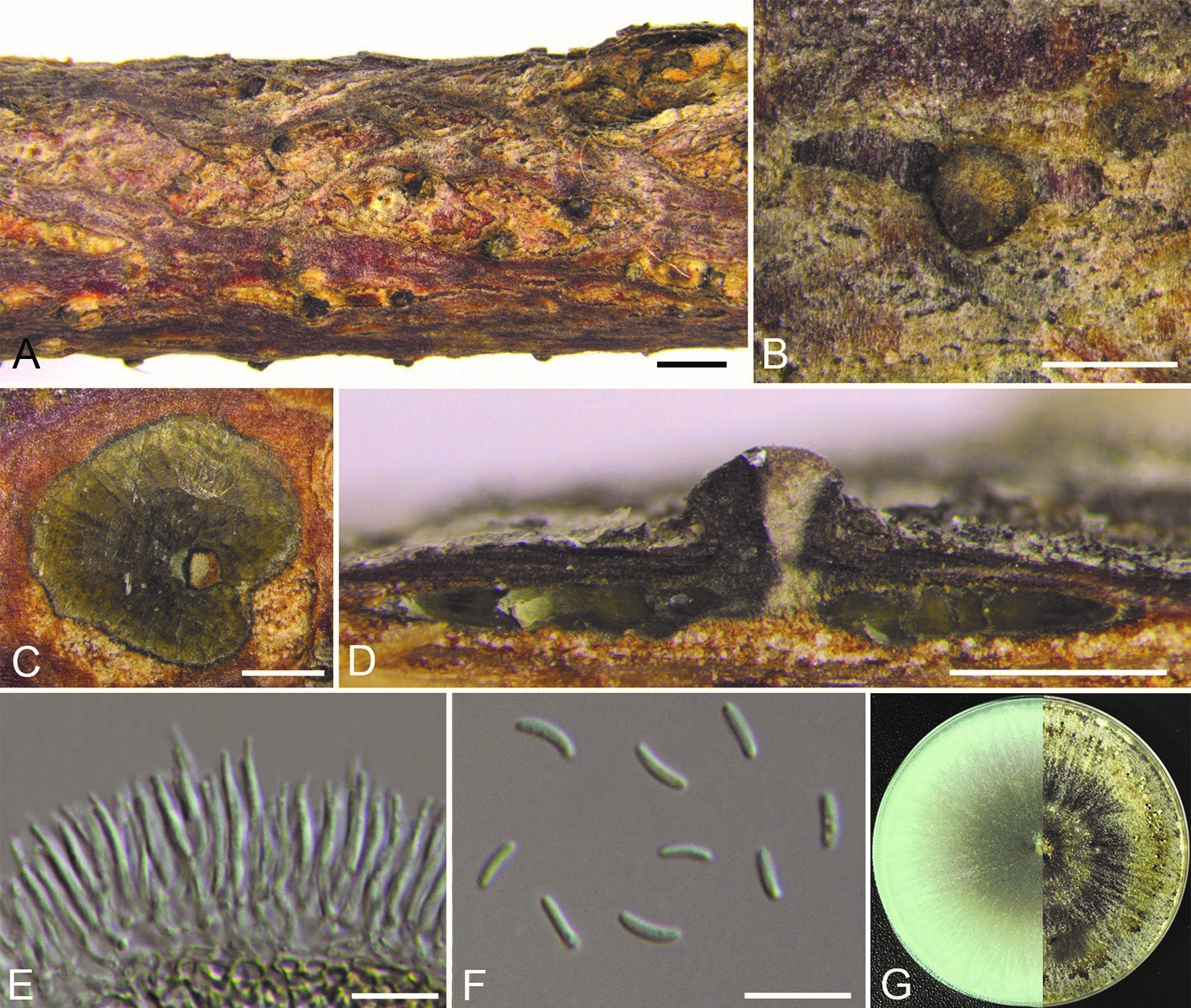 194
194
Cytospora coryli H.Y. Zhu & X.L. Fan, sp. nov. 2020
MycoBank No 833820
Holotype: China, Beijing City, Mentougou District, Mount Dongling, Xiaolongmen Forestry Centre (115°27'07.00"E, 39°59'26.47"N), from branches of Corylus mandshurica, 17 Aug 2017, H.Y. Zhu & X.L. Fan, holotype CF 2019813, ex-type living culture CFCC 53162.
Morphological description
Necrotrophic on branches of Corylus mandshurica. Sexual morph: not observed. Asexual morph: Conidiomata pycnidial, flat, immersed in the bark, scattered to gregarious, erumpent through the surface of bark, surrounded by conspicuous black stroma walls in the margin, with multiple locules. Conceptacle absent. Ectostromatic disc grey to black, discoid, circular to ovoid, 270–340 µm in diam., with one ostiole per disc. Ostiole grey to black, at the same or above level as the disc surface, inconspicuous. Locules numerous, subdivided frequently by invaginations with common walls, circular to irregular, 1550–1710 µm in diam. Conidiophores hyaline, branched at the base, in the middle, approximately cylindrical with the top end acute, 15.5–18.5 × 1–2 (av. = 17 ± 1.2 × 1.1 ± 0.2, n = 10) µm, sometimes reduced to conidiogenous cells. Conidiogenous cells enteroblastic, phialidic, sub-cylindrical to cylindrical, 7.5–14 × 1–2 (av. = 9.3 ± 1.7 × 1.4 ± 0.2, n = 10) µm. Conidia hyaline, allantoid, smooth, aseptate, thin-walled, 5–7 × 1–2 (av. = 5.6 ± 0.5 × 1.4 ± 0.2, n = 30) µm.Culture characteristics. Cultures are initially white with hazel at the centre, growing fast up 9 cm in diam. after 3 days, becoming honey to hazel from the edge to centre after 7–10 days. In reverse, the cultures are the same as the upper colour after 3 days, becoming cinnamon from the edge to centre after 7–10 days. Colonies are flat, sparse at the centre and compact to the margin. Pycnidia distributed radially on colony surface.
Habitat: from branches of Corylus mandshurica
Distribution: Mount Dongling, China.
GenBank Accession:
Notes: Cytospora coryli is associated with canker disease of Corylus mandshurica in China. The only strain CFCC 53162 representing Cytospora coryli clusters as a single lineage and appears mostly related to C. euonymicola from Euonymus kiautschovicus and to Cytospora gigalocus from Juglans regia (Fan et al. 2015a, 2020) (Fig. 2). Cytospora coryli differs from C. euonymicola by its larger locules (1550–1710 vs. 1150–1400 µm) and larger conidia (5–7 × 1–2 vs. 4.5–5 × 1 µm) (Fan et al. 2020), C. coryli differs from C. gigalocus by its smaller locules (1550–1710 vs. 1630–2180 µm) with single ostiole (one to five ostioles in C. gigalocus) and the larger size of conidia (5–7 × 1–2 vs. 4.6–5.6 × 0.8–1.3 µm) (Fan et al. 2015a). Based on morphology and sequence data, we describe it as a new species.
Reference: Zhu H, Pan M, Bezerra JDP et al. (2020) Discovery of Cytospora species associated with canker disease of tree hosts from Mount Dongling of China.
Cytospora coryli from Corylus mandshurica (CF 2019813). A, B habit of conidiomata on twig C transverse section of conidioma D longitudinal section through conidioma E conidiophores and conidiogenous cells F conidia G colonies on PDA at 3 days (left) and 30 days (right). Scale bars: 1 mm (A); 500 µm (B–D); 10 µm (E, F).

